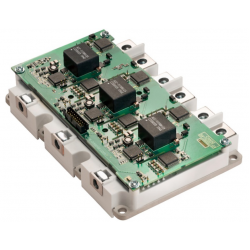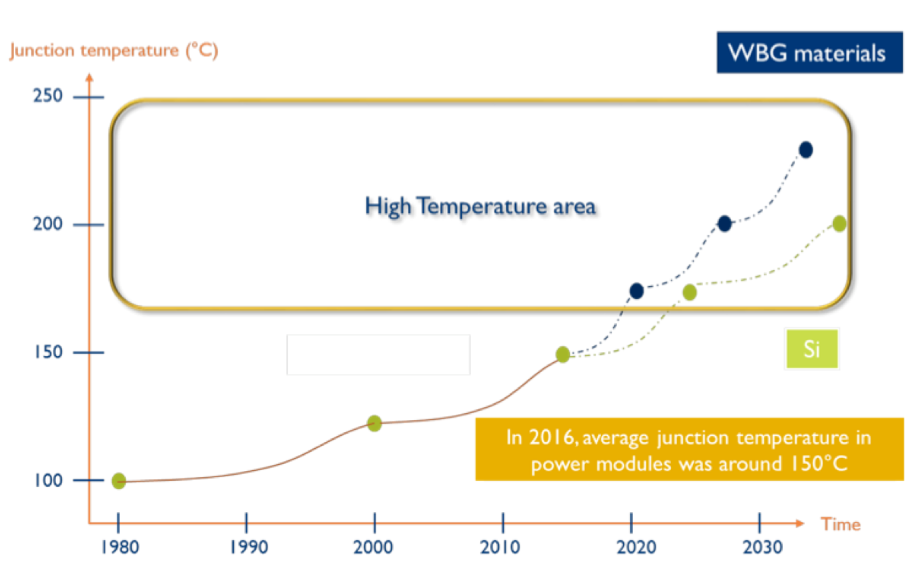SiC helps the application of power semiconductor devices to increase junction temperature, which will greatly change the design pattern of power systems.

SiC helps the application of power semiconductor devices to increase junction temperature, which will greatly change the design pattern of power systems.
Since the birth of silicon power semiconductor devices, application demands have been driving the junction temperature to rise, which has now reached 150°C. With the emergence of third-generation wide-bandgap semiconductor devices (such as SiC) and their increasing maturity and full commercialization, their unique high-temperature resistance is accelerating the junction temperature from the current 150°C to 175°C, and will enter 200°C in the future. . With the unique high-temperature characteristics and low switching loss advantages of SiC, this trend of increasing junction temperature will greatly change the design pattern of power systems. These typical, future-oriented high-temperature, high-power-density applications include deeply integrated electric vehicle powertrains, multi-electric and all-electric aircraft and even electric aircraft, mobile energy storage charging stations and power bank, as well as various liquid cooling are seriously affected. Restricted power applications.

The application junction temperature of power devices is constantly rising (from a market research report by Yole Development)
The powertrain of electric vehicles (motor, electronic control and gearbox) has moved towards three-in-one, but currently it is only structurally stacked together and is weakly integrated. Structurally speaking, in the future, deep integration of the powertrain is an inevitable path, because this may reduce the volume by about one-third, the weight by about one-third, and the internal consumption by about one-third, and may also reduce the total cost. Compress 2 to 4 times. However, the electronic control part will be closely integrated with the motor, and deep integration will greatly increase the power density. High temperature is the biggest challenge that cannot be avoided.
In traditional aircraft, the mechanical movements such as tail rudder, wings, and landing gear are controlled by classic hydraulic transmission. As a liquid, hydraulic oil is greatly affected by the environment and has high maintenance costs. Currently, there is a trend towards partial or complete electrification, which is the concept of multi-electric and all-electric aircraft. Electric motors are used to replace hydraulic oil circuits on aircraft to achieve mechanical operation, which has high reliability, strong maintainability, and facilitates redundant backup design. However, the biggest dilemma is that the motors and electronic controls on the aircraft are not allowed to be equipped with water cooling, and can only rely on forced air cooling and natural cooling. Therefore, the electronic control design of multi-electric or all-electric aircraft, or even electric aircraft, needs to be solved first. The major technical problem is high temperature.
In addition, in many application scenarios, semi-mobile energy storage charging stations and fully mobile power bank will effectively fill the gap of fixed charging, especially with the large-scale popularization of electric vehicles, this will become more obvious. However, for this type of mobile charging application, the water-cooling mechanism will not only bring additional weight and volume burdens, but more importantly, it will consume the stored electricity it carries. Therefore, natural cooling will be the best way for electronic control, but it must be handled properly. Solve the problem of thermal management of electronic control systems.
In addition to the above three typical high-temperature applications, in many special industrial applications where liquid cooling is severely limited, electronic control systems will face the same high-temperature challenges. High-temperature-resistant electronic control technology is the key to realizing the above high-temperature applications. Its core implementation technology is the high-temperature packaging technology of SiC power devices and the matching high-temperature drive circuit technology.
SiC materials and their device structures have inherent high temperature resistance, and can even withstand temperatures of 400 to 600°C under vacuum conditions. In practical applications, in order to prevent oxidation caused by contact with air, SiC devices must be packaged, and if they are to withstand high temperatures, they must be packaged in high-temperature resistant packages. The junction temperature of 150℃ is the current highest standard in the industry. The 175℃ junction temperature level has just begun to be revealed. There are quasi-standardized packages that can be used. Packages with 200℃ or higher temperatures have very strict requirements on packaging materials and processes, and must be based on the bare die. Features are custom designed to ensure thermal conductivity and heat dissipation performance requirements.
The application of SiC power devices and modules is inseparable from drive circuits and their corresponding chips. However, most driver circuit chips are ordinary silicon devices and cannot withstand high temperatures. If they can work at high temperatures such as 175°C for 1,000 hours, they are already rare. In addition, high temperature resistance is only one aspect of the problem. What is more serious is the consistency of device performance at high temperatures. The performance of ordinary silicon devices weakens very quickly above 70°C, so they cannot be used at high temperatures. After more than 20 years of innovative R&D and application testing, Cissoid's SOI special silicon devices have achieved outstanding high temperature resistance. They can operate continuously for 15 years at 175°C and have excellent performance consistency across the entire temperature range. , is the pillar supporting SiC high-temperature applications.
Cissoid's SOI-based special silicon semiconductor technology comprehensively breaks through the temperature dilemma of silicon semiconductor devices and clearly avoids the temperature carrier effect (intrinsic carrier concentration increases with temperature) and junction temperature of silicon devices. Influenced by the effect (the effective junction barrier shrinks as the temperature increases), it can not only withstand high temperatures and work for a long time, but also maintain good performance consistency across the entire temperature range. Therefore, Cissoid's high-temperature semiconductor devices have long been favored by the aerospace and oil exploration fields, and have nearly two decades of high-temperature application history and experience. In recent years, with the popularity of third-generation semiconductor SiC power devices, Cissoid has developed high-temperature-resistant driver chips and solutions for SiC MOSFETs. This unique high-temperature resistance allows it to be placed as close as possible to the SiC power module to minimize the parasitic inductance of the drive loop, thereby more effectively suppressing ringing and achieving optimal efficiency.
Recently, for power electric drive applications in electric vehicles and all-electric/multi-electric aircraft, Cissoid has also launched a three-phase full-bridge 1200V SiC MOSFET intelligent power module (IPM) system, which is a scalable platform series. This system utilizes low switching loss technology to provide an integrated solution, namely IPM. IPM is composed of a gate drive circuit and a three-phase silicon carbide power module. The cooperation between the two has been optimized and coordinated to fully utilize the advantages of SiC devices. The currently produced CXT-PLA3SA12450AA module has a rated junction temperature of up to 175°C, and the gate drive circuit can operate in an environment up to 125°C. In addition, as application conditions and scenarios require, the operating temperature level can be further improved by replacing higher-level passive components and the packaging of main chips and modules.

CXT-PLA3SA12450AA three-phase full-bridge 1200V/450A SiC MOSFET intelligent power module
Since the birth of silicon semiconductor devices, high-temperature applications have been the key to their applications. Cissoid's innovative special SOI silicon chip technology has taken the lead in achieving major breakthroughs in high-temperature semiconductor discrete devices and small-scale integrated circuits. As third-generation semiconductors such as SiC power semiconductor devices become increasingly mature and popular, their inherent high-temperature resistance and Cissoid high-temperature semiconductor devices form a very good match, which will greatly change the pattern of power system design and provide design engineers with A new space for expansion.
 Notable: Cissoid is a leader in high-temperature semiconductors for demanding markets. Cissoid brand product series, jinftry official website has agents for sale. The price advantage is obvious, limited inventory is available for sale, and orders are accepted at the same time. The order cycle is short. Welcome to consult.
Notable: Cissoid is a leader in high-temperature semiconductors for demanding markets. Cissoid brand product series, jinftry official website has agents for sale. The price advantage is obvious, limited inventory is available for sale, and orders are accepted at the same time. The order cycle is short. Welcome to consult.


